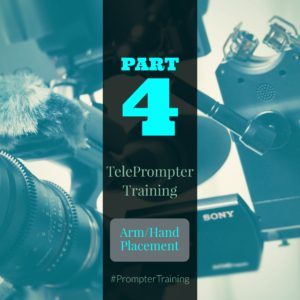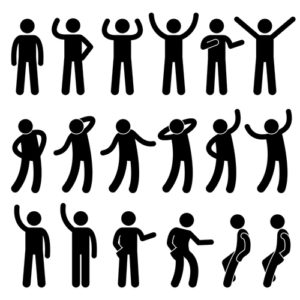
teleprompter training: part 4
There is this myth out there that you shouldn’t use your arms or use too many gestures when you are presenting. But I’d suggest that you completely ignore this myth! It’s natural for everyone to speak using their arms and hands while speaking to one another. This same principal applies when you are presenting or filming. You should use your arms and hands in a natural way to appear confident and comfortable.
A person can be natural and animated while speaking to me in person. But the minute I put them in front of the camera they become stiff, monotone and never move their hands. It’s one of the first things I always work on with clients. The biggest advice I can give you is to do what comes naturally. If you try to insert choreographed gestures you will most likely come off looking stiff and unnatural.
Now having said that, if you are reading from a teleprompter you will most likely need to stay within the “strike-zone.” If you are familiar with baseball (or softball in my case – I’m a huge fan!) the strike zone is the area batters will most likely hit a ball – or where a batter will find their sweet spot. The strike zone for presenters is from your shoulders to the top part of your hips. It’s the presenter’s sweet spot.
You typically want to stay within this zone so that your hands are not cut off from being filmed. When you are being filmed while using a teleprompter it usually means that the camera has a tight shot on you. So if you use wide gestures your hands and arms may not be shown at all because they are out of frame.
As you add in gestures while your presenting here are some quick do’s and don’ts for using your hands and arms.

Do’s:
- Incorporate your natural hand and arm gestures as best you can.
- Use descriptive hand movements to communicate an idea or movement. Like how small something is or holding 3 fingers up to signify the number 3.
- Keep your hands in the strike zone.
- Use symbolic gestures to communicate words or position.
- Use emotional gestures to communicate feelings. For example a thumbs up is great if you want to convey a good review.
Don’ts:
- Draw attention to the wrong places. For example don’t clasp your hands in front of your groin. Communication pros call it the “fig leaf” look and you probably don’t want to channel Adam and Eve while your filming.
- Fold your arms. This makes you look guarded and ready to argue.
- Place your hands on your hips. You may end up looking like an overbearing parent. It’s OK to place one of your hands on your hips every now and again but overall avoid both hands on your hips.
- Put your hands in your pockets. It can make you look nervous. And when both of your hands are in pockets it can cause you to be stiffer because you won’t naturally be moving your shoulders or having great posture because you hands are stuck in your pockets.
- Clasp your hands behind your back. It just doesn’t look natural and the viewers will find it distracting after a while.
- Point at the audience. It just looks aggressive and the viewers won’t like you for it.
At some point during your filming session, you will most likely find yourself doing something you shouldn’t. But there is good news. You can just reset. Here’s how to reset: simply drop your hands to your sides for a second or two. Keeping with the baseball analogies – having your arms at your side is like home base. Whenever you’re unsure what to do, just go back to home base. Just don’t keep your arms there forever, it’s a temporary place – remember you only score after touching all the bases.
Challenge:
I encourage you to film yourself at home giving a few lines of a prepared script. Watch it over and see how natural your arm movement is. If it’s not great, try more gestures, then try less until you find the right mix that works for you. Remember practice makes perfect!

